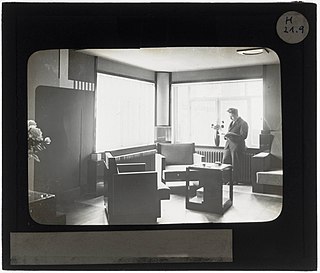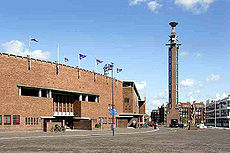
De Stijl, incorporating the ideas of Neoplasticism, was a Dutch art movement founded in 1917 in Leiden, consisting of artists and architects. The term De Stijl is also used to refer to a body of work from 1917 to 1931 created in the Netherlands. Proponents of De Stijl advocated pure abstraction and universality by a reduction to the essentials of form and colour. They simplified visual compositions to vertical and horizontal, using only black, white and primary colors.

Joan (Jo) Melchior van der Mey was a Dutch architect best known for the landmark Scheepvaarthuis building in Amsterdam located at Prins Hendrikkade, 1912.

Michel de Klerk was a Dutch architect. Born to a Jewish family, he was one of the founding architects of the movement Amsterdam School

Expressionist architecture was an architectural movement in Europe during the first decades of the 20th century in parallel with the expressionist visual and performing arts that especially developed and dominated in Germany. Brick Expressionism is a special variant of this movement in western and northern Germany, as well as in the Netherlands.

Pieter Lodewijk (Piet) Kramer was a Dutch architect, one of the most important architects of the Amsterdam School.

Berend Tobia Boeyinga was a Dutch architect noted for his Calvinist church buildings and as a practicing member of the Amsterdam School.

Eduard Cuypers was a Dutch architect. He worked in Amsterdam and the Dutch East Indies.

Wendingen was an architecture and art magazine that appeared from 1918 to 1932. It was a monthly publication aimed at architects and interior designers. The booklet was published by Amsterdam publisher Hooge Brug (1918–1923) and by the Santpoort publisher C.A. Mees (1924–1931). It was a mouthpiece for the architect association Architectura et Amicitia.. The chief editor was the architect Hendricus Theodorus Wijdeveld. Wendingen initially was an important platform for Dutch expressionism, also known as the Amsterdam School, and later endorsed the New Objectivity.

Dutch architecture has played an important role in the international discourse on architecture in three eras. The first of these was during the 17th century, when the Dutch empire was at the height of its power. The second was in the first half of the 20th century, during development of modernism. The third is not concluded and involves many contemporary Dutch architects who are achieving global prestige.

Traditionalist architecture is an architectural movement in Europe since the beginning of the 20th century in the Netherlands, Scandinavia, Germany et al. In the Netherlands Traditionalism was a reaction to the Neo Gothic and Neo-Renaissance styles by Pierre Cuypers. One of the first influential buildings of Traditionalism was the Beurs van Berlage in Amsterdam, finished in 1903. Since the 1920s Traditionalist architecture has been a parallel movement to Modern architecture.

The term Brick Expressionism describes a specific variant of Expressionist architecture that uses bricks, tiles or clinker bricks as the main visible building material. Buildings in the style were erected mostly in the 1920s, primarily in Germany and the Netherlands, where the style was created.

Herman Ambrosius Jan Baanders, also known by his initials as H.A.J. Baanders, was a Dutch architect, designer and entrepreneur who was active in the Amsterdamse School style of architecture. He designed the Amsterdams Lyceum, among others.

Nieuwe Pijp is a neighbourhood in Amsterdam, Netherlands. It is part of the borough of Amsterdam-Zuid. The Nieuwe Pijp is bordered by Ceintuurbaan and Sarphatipark in the north, Van Woustraat in the east, Amstel Canal in the south and Boerenwetering canal in the west. Along with the Oude Pijp, situated north of the Nieuwe Pijp, it is often simply referred to as De Pijp.

The Plan Zuid is an urban development plan of Amsterdam South in the city of Amsterdam, Netherlands, designed by architect Hendrik Petrus Berlage. Berlage was responsible for the urban concept (1915) and the architects of the Amsterdam School designed the implementation of the plan.

New Indies Style is a modern architectural style used in the Dutch East Indies between the late 19th century through pre-World War II 20th century. New Indies Style is basically early modern (western) architecture, which applies local architectural elements such as wide eaves or prominent roof as an attempt to conform with the tropical climate of Indonesia.
Liem Bwan Tjie was a prominent architect, and a pioneering figure of modern Indonesian architecture. He belonged to the first generation of professionally trained Indonesian architects.

Karel Petrus Cornelis de Bazel was a modern Dutch architect, engraver, draftsman, furniture designer, carpet designer, glass artist and bookbinding designer. He was the teacher of Adriaan Frederik van der Weij and the first chairman of the Bond van Nederlandse Architecten, beginning in 1909.

Hubrecht (Huib) Hoste was a Belgian architect, designer and urban planner. He is considered the pioneer of modern architecture in Belgium.

The Berlagebrug is a bascule bridge over the river Amstel in Amsterdam, Netherlands. The bridge was commissioned by the Amsterdam municipality and designed by engineer Cornelis Biemond (1899-1980) and architect Hendrikus Petrus Berlage (1856–1934); it was named after the latter. It was constructed from 1926 to 1931 and officially opened on 28 May 1932. It has been designated as a Rijksmonument since 11 May 2008. The bridgekeeper's house carries the address Amsteldijk 134.


























